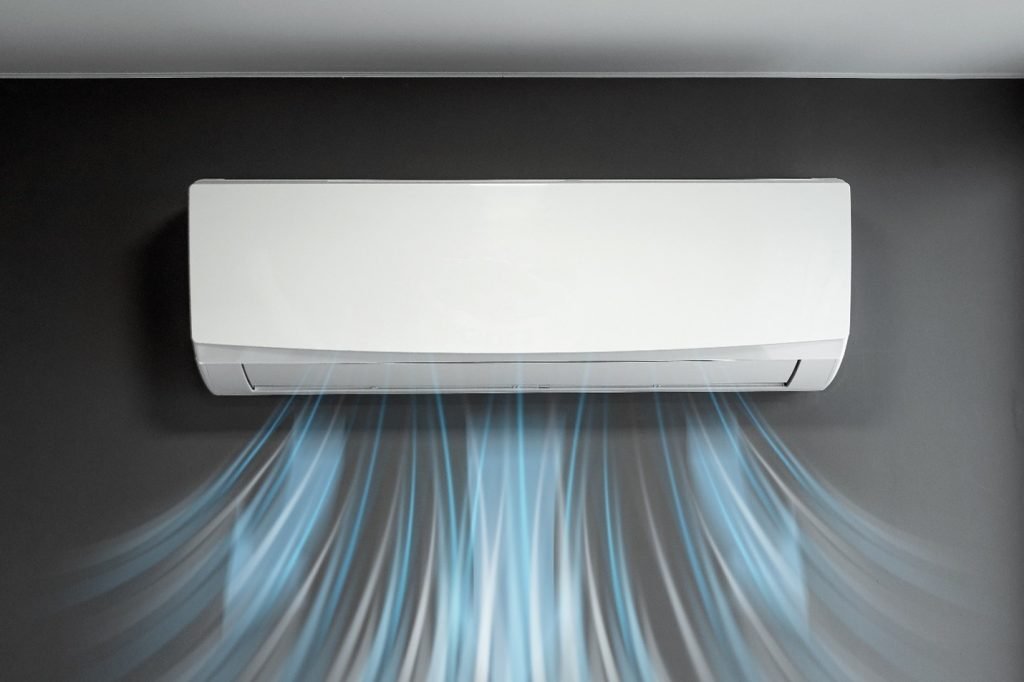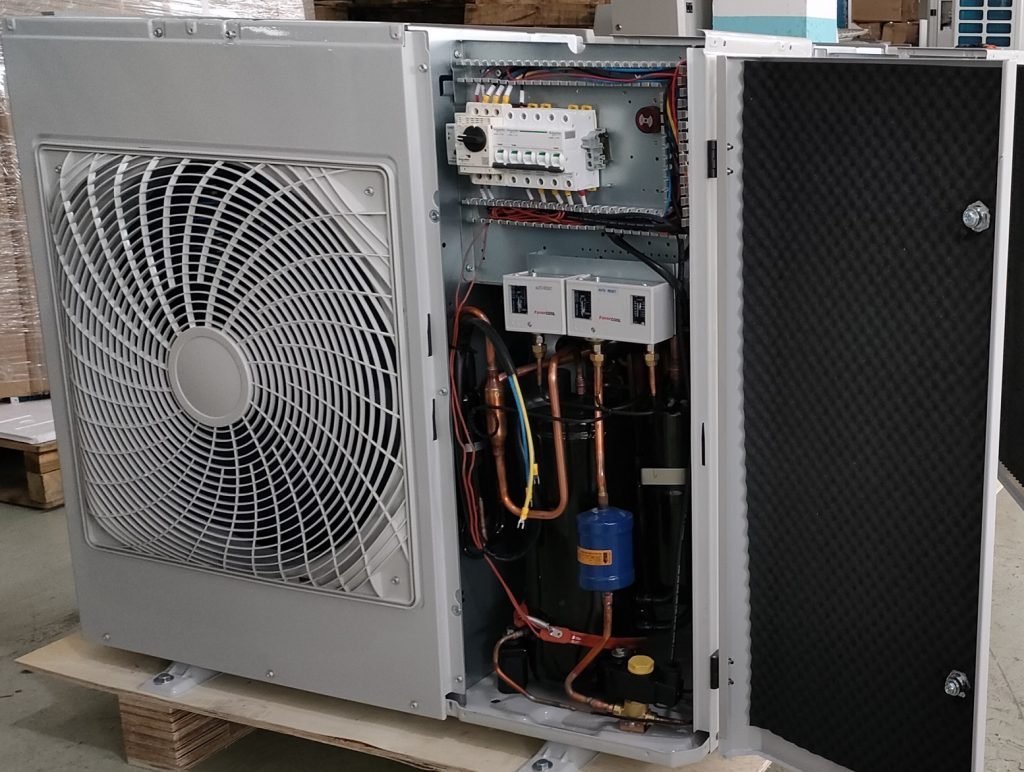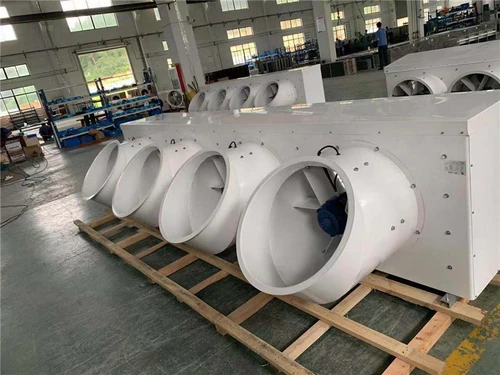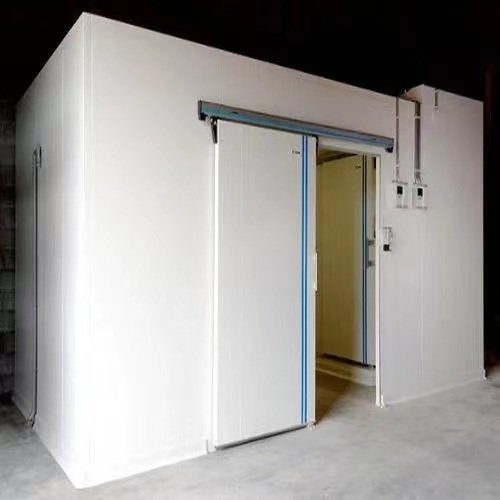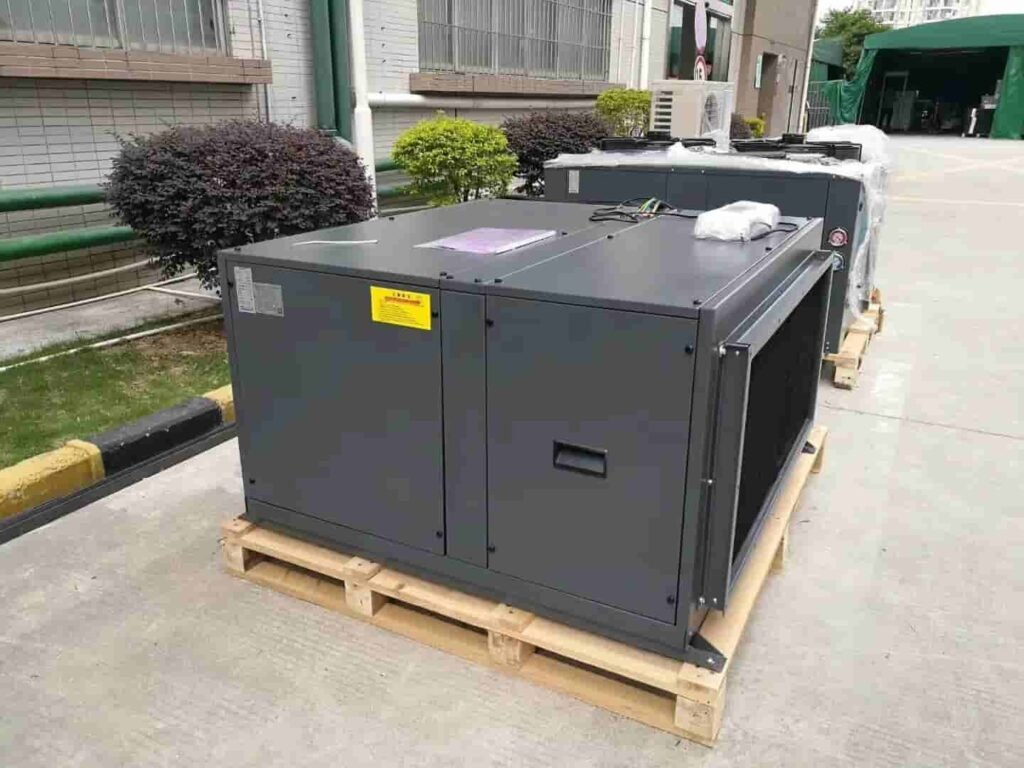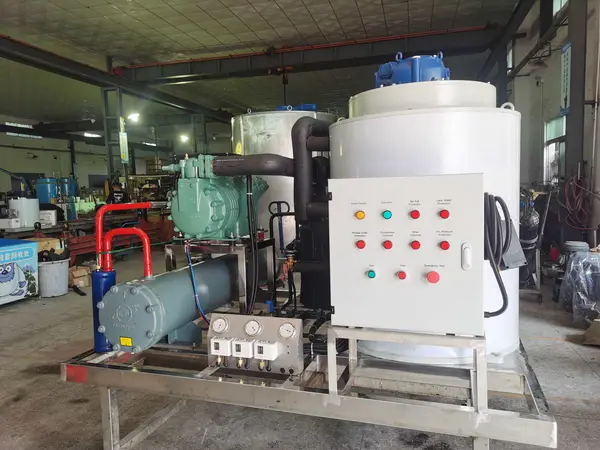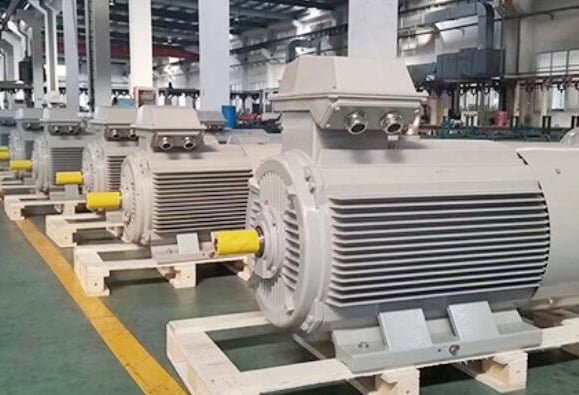Modern cruise ships navigating the vast oceans are like moving “seaside cities,” and one of the core components supporting the operation of this massive entity is the cold room system hidden beneath the decks.
It is not only the lifeline for preserving the daily food supply of thousands of passengers, but it must also maintain precise functionality amid shaking, salt corrosion, and extreme weather conditions.
The cruise ship 寒い部屋 system seamlessly blends science and engineering, silently withstanding the harsh challenges of the sea, making it an unseen “low-temperature revolution” in modern maritime technology.
Unique Features of Cruise Ship Cold Room
Dynamic Stability
Cruise ship cold room system must maintain a consistent temperature under conditions such as ship rocking (up to 15°), salt mist corrosion (salt concentration ≥3%), and extreme temperature fluctuations (a temperature difference of over 60°C from tropical to polar regions).
Long-Term Self-Sufficiency
For transoceanic voyages, food needs to be stored for more than 30 日々. 例えば, frozen meats must be kept at -22°C, and refrigerated fruits and vegetables need at 0-4°C with 90% 湿度, placing high demands on equipment stability.
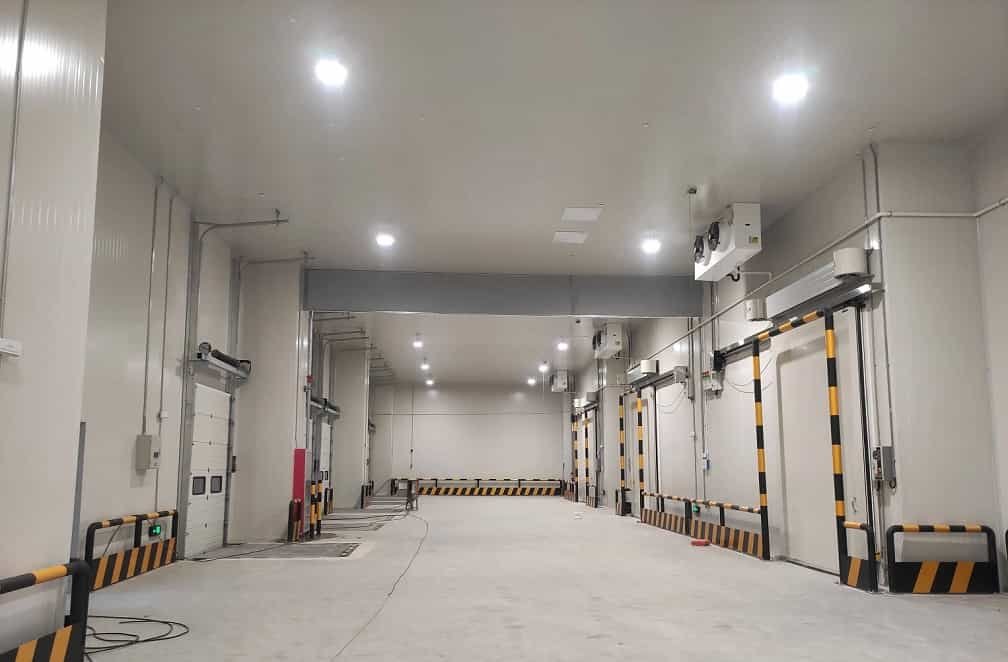
Dependence on Ship’s Generators
Energy consumption of the 寒い部屋 system accounts for 10%-15% of the ship’s total electricity. It competes for resources with the propulsion system and passenger cabin needs. If the main generator fails, the backup power can only support the cold room system for 4-6 時間.
Energy-Saving Technology Priority
Use inverter compressors (保存 50% エネルギー) and heat recovery systems (reuse waste heat for domestic water heating), reducing daily fuel consumption by 200-300 liters.
Inventory Prediction Accuracy
AI algorithms analyze factors such as passenger nationality and seasonal routes (例えば, seafood demand is 30% higher on Alaska routes), achieving a procurement error rate of less than 5%.
High-End Food Storage Capability
Top-tier cruise lines (例えば, Silver Sea Cruises) have ultra-low-temperature storage at -30°C for preserving bluefin tuna and constant humidity wine cellars at 12°C for storing Burgundy wines, which has become a core selling point for attracting high-net-worth clients.
Design Challenges and Adaptive Solutions for Cruise Ship Cold Room
1. Optimal Space and Layout: How to Maximize the Use of Limited Ship Cabin Space?
Challenge: Cruise ship 寒い部屋 needs to store food for thousands of passengers in a compact space, close to kitchens and deck supply ports to shorten transport paths. Traditional horizontal cold room takes up lots of space, competing with other ship functions (such as passenger cabins and entertainment facilities).
SOLUTION:
Vertical Layered Design: Use multi-layer shelving system (通常 3-4 レイヤー, with heights of 1.8-2.2 メートル) to maximize vertical space in the cabin.
Modular Cold Room Units: Prefabricated cold room modules (standard size: 6m×3m×3m) can be flexibly assembled to fit various ship types. Carnival Cruise’s modular cold room supports quick temperature zone changes (例えば, convert a 4°C cold room unit to -18°C frozen storage) to respond to changes in route demands.
Intelligent Flow Planning: Cold room connect to the kitchen and deck loading/unloading ports via electric conveyor belts (スピード: 0.5m/s, load: 500kg per trip), increase transport efficiency by 300% and reduce the frequency of door openings (cutting energy consumption by 15%).
2. Corrosion and Seismic Design: Withstand the Harsh Marine Environment
Challenge: High salt mist environments cause rapid corrosion of metal components, shorten the lifespan of cold room units. The ship’s rocking (with a roll angle of up to 15° and pitch of 5°) can cause cargo displacement and pipe ruptures.
SOLUTION:
あ) Corrosion-Resistant Materials
冷蔵室パネル: 316L stainless steel (と 2.5% molybdenum) offers 3 times better resistance to salt mist corrosion compared to 304 ステンレス鋼.
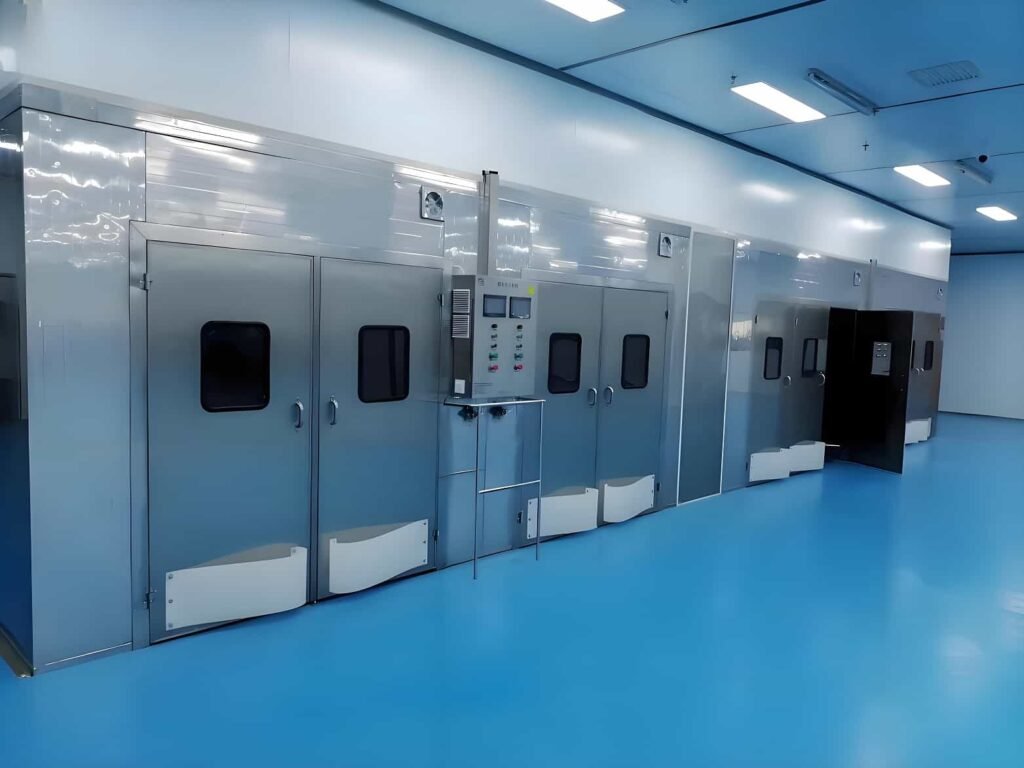
Internal Shelves: Hot-dip galvanized steel (with a zinc layer thickness ≥85μm), with salt mist testing endurance exceeding 1,000 時間.
Sealing Materials: Fluoroelastomer ドア seals (temperature range -40°C ~ 200°C), offering 50% better aging resistance than ordinary rubber.
B) Anti-Vibration and Anti-Displacement Technology
Gravity Lock Shelves: Shelves have electromagnetic locks (automatically locking when power is cut), able to withstand lateral accelerations of 0.3g (equivalent to the inertial force of the ship rocking at 15°).
Flexible Pipeline Connections: Copper refrigerant pipes use corrugated pipe designs (expansion of ±15mm) with elastic brackets (damping coefficient 0.7) to reduce the risk of leakage due to ship vibrations.
Anti-Slip Floor Treatment: The cold room floor is coated with polyurethane anti-slip coating (摩擦係数≥0.6) and embedded with aluminum alloy guide grooves (spacing 1.2m) to secure cargo pallets.
3. Efficient Insulation and Sealing Technology: Combate Cold Air Loss and Increased Energy Consumption
Challenge: The temperature difference between inside and outside of the 寒い部屋 unit on a cruise ship can reach 50°C (例えば, external temperature of 35°C in tropical seas, with internal temperature at -15°C), making traditional insulation materials insufficient for energy-saving needs. Frequent door operations lead to cold air loss, further increasing energy consumption.
SOLUTION:
Vacuum Insulation Panels (VIP): Composed of fiberglass core material and aluminum foil barrier films, with a thickness of only 50mm and thermal conductivity ≤0.005W/(m•K), offering 4 times the insulation efficiency of traditional polyurethane foam: 0.02W/(m•K).
あ) Air-Tight Door Systems
Quick-Closing Airlock Doors: Pneumatically driven (closing time: 0.5 秒), with heated strips around the door gaps (maintain 40°C) to prevent icing. Cold air loss per door opening is reduced by 70%.
Double-Door Transition Chambers: A transition chamber (1.5m deep) at the 寒い部屋 entrance, with two doors opening alternately to block direct airflow between the inside and outside.
Intelligent Seal Monitor: Pressure sensors (accuracy ±0.1Pa) on the door gaps detect sealing status in real time. If abnormal pressure is detected (例えば, seal failure), will trigger an alarm, and activate the backup magnetic door latch (with a holding force ≥500N).
4. Adaptation to Extreme Environments: Refrigeration Capabilities from Tropical to Polar Regions
Challenge: Tropical seas feature high temperatures and humidity (例えば, Caribbean summer deck temperature of 45°C, 90% 湿度), causing the 冷蔵室冷凍システム to experience heavy loads.
In polar routes, low temperatures (-30℃) cause the outer layer of the cold room to ice, affecting insulation performance.
SOLUTION:
あ) Enhanced Refrigeration for Tropical Environments
Two-Stage Compression Refrigeration System: A high-temperature compressor (COP 4.2) pre-cools the air, and a low-temperature compressor (COP 2.8) further reduces the temperature, improving the overall system efficiency by 30%.
Seawater-Cooled Condenser: Utilizes seawater (temperature ≤32°C) from beneath the ship to cool the refrigerant, offering 40% more energy efficiency than air-cooled condensers.
B) Anti-Icing Measures for Polar Regions
Electric Heating Films: Carbon fiber heating films (力: 200W/m²) embedded in the outer wall of the 寒い部屋 maintain a temperature above 0°C, prevent condensation from freezing.
Additional Insulation Layer: Add a 50mm thick aerogel blanket, thermal conductivity 0.018W/(m•K), to the outer layer of cold room on polar routes, improve overall thermal resistance by 25%.
Cruise Ship Cold Room Pipeline and Wiring Layout
私. Pipeline System Design
1. Refrigerant Pipeline Layout
あ) 材料の選択
Main Refrigerant Pipeline: Seamless copper pipes (ASTM B280 standard), wall thickness ≥1.5mm, pressure resistance ≥4.2MPa, suitable for refrigerants such as ammonia (NH₃) and CO₂.
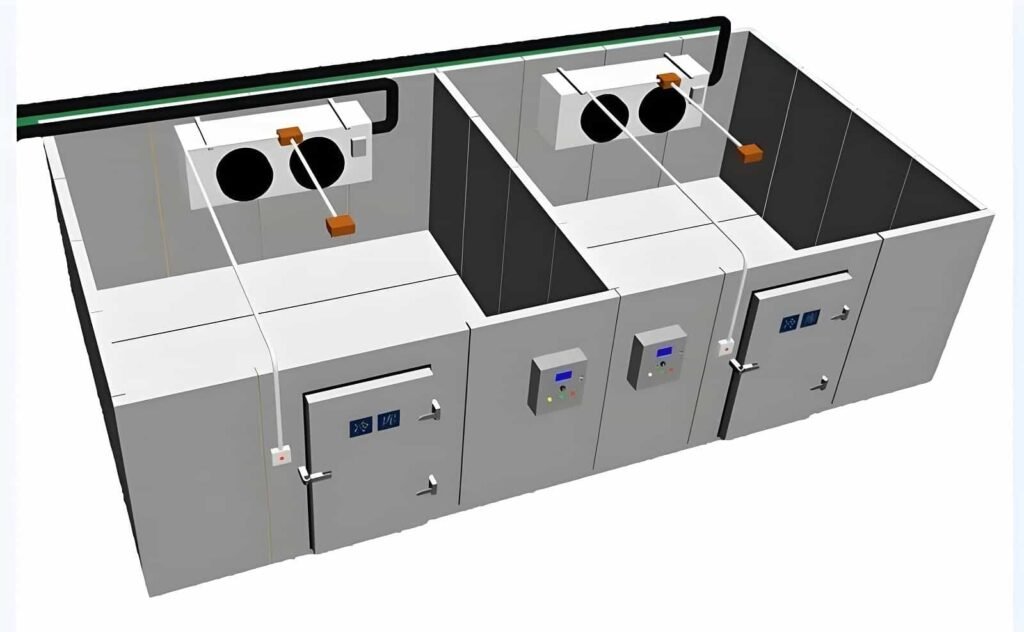
Corrosion Protection: The outer wall is coated with a PVC (ポリ塩化ビニル) corrosion-resistant layer (厚さ: 2んん), and the inner wall is nickel-plated (厚さ: 50μm), improving salt mist corrosion resistance and extending the lifespan to 20 年.
B) Layout Principle
Layered Pipe Routing: The main liquid supply pipe (diameter 50-80mm) is located at the top of the 寒い部屋, while the return gas pipe (diameter 80-120mm) is located at the bottom. The distance between vertical branch pipes is ≤2m, reducing pressure drop (ΔP < 5%).
ハ) Seismic Design
Corrugated Pipe Compensators: Install stainless steel corrugated pipes (expansion capacity ±15mm) 毎日 6 meters to absorb pipe displacement caused by ship rocking.
Elastic Hangers: Rubber damping hangers (damping coefficient 0.7) allow for lateral movement of pipes up to ±10cm.
D) Insulation Treatment
断熱材: Closed-cell elastomeric foam (thermal conductivity 0.033W/(m•K)), with thickness designed based on the temperature gradient (例えば, 60mm insulation for -30°C pipes).
Outer Protective Layer: Aluminum foil composite fiberglass (tensile strength ≥50MPa) to prevent mechanical damage and UV degradation.
2. Condensate and Drainage Pipes
Slope Design: The slope of the drainage pipe is ≥3% to ensure that condensate flows naturally to the ship’s bottom collection chamber (capacity: 500-1000L), preventing water accumulation and bacterial growth.
あ) Anti-Freeze Measures
Heating Tape: Wrap a self-regulating heating tape (15W/m power) around the outside of the drainage pipe to maintain pipeline temperature >5℃, preventing blockages caused by freezing in polar environments.
材料要件: UPVC pipes (corrosion-resistant and temperature-resistant down to -40°C) with solvent-based adhesive joints to prevent leaks.
ii. Electrical Wiring System Design
1. Power Supply Wiring Layout
あ) Cable Selection
Main Power Line: Halogen-free, low-smoke, flame-retardant cables (IEC 60092 standard), with cross-sectional area chosen at 1.25 times the load current (例えば, for a 100A load, use 25mm² cable).
Low-Temperature Environment Cables: Silicone rubber-insulated cables (温度範囲: -60°C to 180°C), used for connecting internal cold room equipment.
B) Routing Path
Cable Trays: Install galvanized steel cable trays (width 200mm, height 100mm) at the top of the 寒い部屋, with power cables (upper layer) and control cables (lower layer) laid in separate layers, with a spacing of ≥300mm to avoid electromagnetic interference.
Deck Penetration Protection: Cables passing through decks are protected with waterproof sealing glands (IP68 rating) to prevent seawater infiltration.
ハ) Redundancy Design
Dual Power Circuits: Core equipment (例えば, コンプレッサー, temperature control systems) is powered by two independent circuits, with a switching time <0.1 秒.
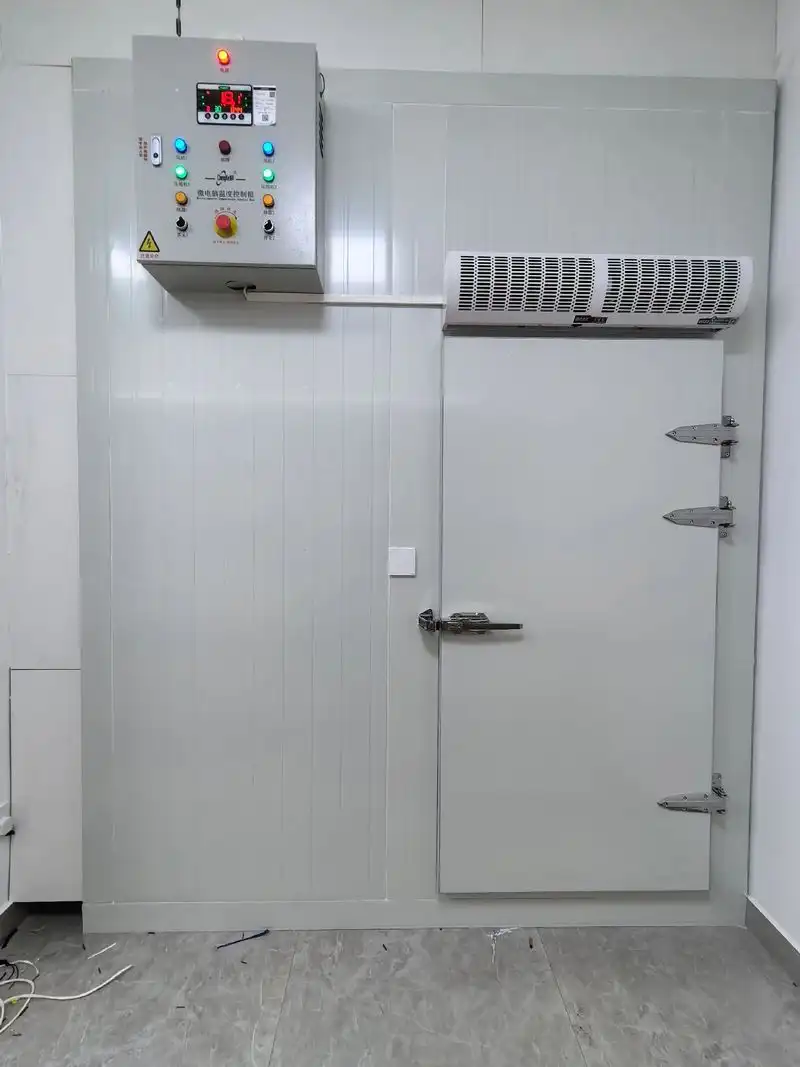
2. Control and Signal Wiring
あ) Anti-Interference Measures
Shielded Twisted-Pair Cables: Sensor signal cables use STP (Shielded Twisted Pair) cables (shielding coverage ≥90%), with grounding resistance ≤1Ω, to suppress electromagnetic noise.
Fiber Optic Communication: Use multi-mode fiber optic cables (attenuation ≤3dB/km) for long-distance transmission (例えば, between decks), avoid voltage drops and interference.
B) Moisture-Proof Sealing
Junction Boxes: Junction boxes inside the 寒い部屋 are made from stainless steel (316L), filled with epoxy resin sealant (waterproof rating IP69K).
iii. Special Environmental Response Technology
1. Salt Mist Corrosion Resistance
Pipeline and Cable Protection: The outer surface is coated with a zinc-aluminum coating (thickness 80μm) and polyurethane topcoat (thickness 50μm), with salt mist testing endurance ≥2,000 hours.
Cable joints are sealed with silicone rubber caps (salt mist resistance rating ASTM B117).
2. Seismic and Vibration Resistance
Pipeline Fixing: Install anti-seismic supports every 1.5 メートル (load ≥500kg), with the supports welded to the ship’s structure (weld strength ≥90% of the base material).
Cable Anti-Loosening: Install nylon zip ties (tensile strength ≥50kg) in the cable trays (spacing ≤0.5m) to prevent cables from shifting due to ship movement.
3. Thermal Expansion Compensation
Pipe Compensators: Install omega-type expansion joints (compensation capacity ±10mm) every 20m along the straight pipe sections to absorb thermal stress caused by temperature variations.
Cable Expansion Allowance: Reserve a “S” shape bend (length ≥1m) at the cable ends, allowing for a ±5% length change.
IV. Detection and Maintenance
1. Leakage Monitor
あ) Refrigerant Leakage Sensors
Ammonia Refrigeration System: Install electrochemical sensors (detection limit ≤5ppm), with one sensor per 50m².
CO₂ Refrigeration System: Infrared absorption sensors (detection limit ≤1000ppm) provide real-time data transmission to the control center.
2. Insulation Testing
Regular insulation resistance checks of cables are conducted using a megohmmeter (2,500V DC), with a minimum resistance of ≥100MΩ. If aging is detected, immediately replace the cable.
3. Automated Inspection
Use rail-based inspection robot (例えば, SMP Robotics S5) with a thermal imager and gas detectors performs a full pipeline scan once a month, generating a 3D defect map.
Safety and Emergency Measures
The safety management of cruise ship 寒い部屋 must ensure “zero accidents” under the challenges of confined spaces, low-temperature environments, and the unique risks of the maritime environment (such as ship rocking and salt mist corrosion).
The emergency measures should cover multiple scenarios, including equipment failures, personnel safety, fire, and leaks.
Below are detailed breakdowns of the key technical requirements and operating standards.
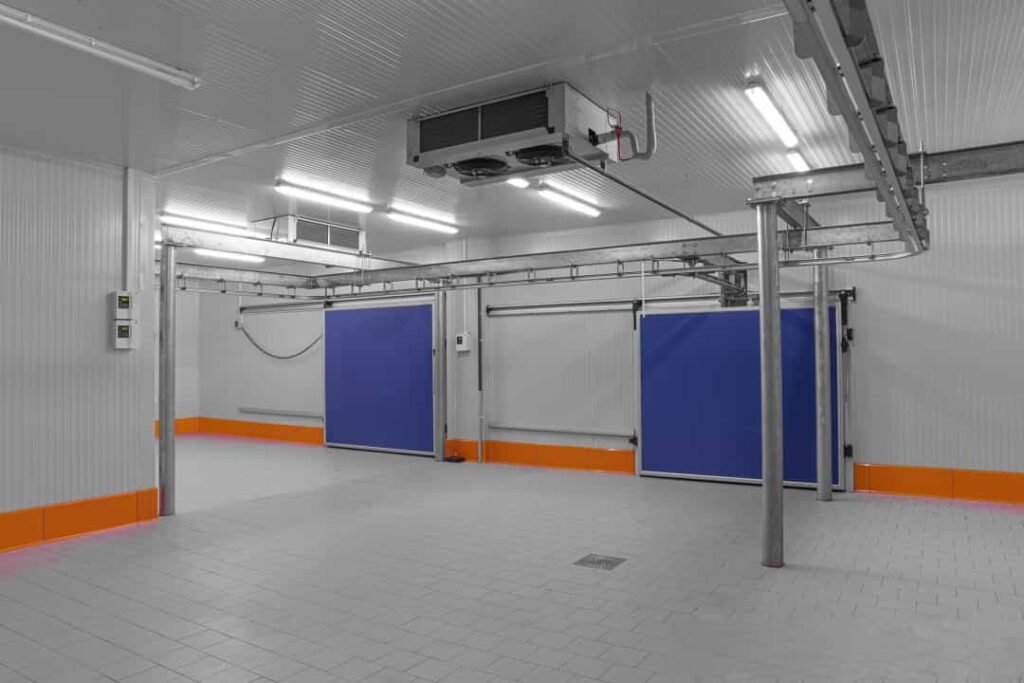
私. Fire Prevention and Explosion Protection Measures
1. Fire Protection Design Standards
Material Flammability: The cold room wall insulation uses flame-retardant polyurethane (oxygen index ≥28%), with the outer protective layer made of galvanized steel plates (melting point 419°C), meeting IMO A-60 fire protection standards (backside temperature ≤180°C within 60 分).
Cables are halogen-free and low-smoke (IEC 60332-3-22 standard), with smoke density ≤50% and the release of toxic gases (例えば, HCl) ≤5%.
あ) Active Fire Extinguishing System
CO₂ Fire Suppression System: Embedded CO₂ nozzles inside the 寒い部屋 (coverage density ≥1kg/m³), releasing CO₂ within 30 秒, reduce oxygen concentration to below 15%.
Water Mist Fire Suppression System: For electrical fires, use high-pressure fine water mist (particle size ≤200μm), with a spray rate of 2L/min•m² to avoid equipment damage caused by traditional sprinkler systems.
2. Explosion Protection Design
Ammonia Refrigeration System Explosion Protection: Install ammonia gas leak sensors (detection limit ≤10ppm) within the cold room, linked to explosion-proof fans (airflow ≥2000m³/h).
Electrical equipment is rated Ex d IIB T4 (surface temperature ≤135°C), preventing ignition risks from electrical sparks.
Flammable Refrigerant Control: For R290 (プロパン) 冷媒, the cold room uses a concentration monitoring system, with the explosion lower limit (LEL) set at 20% for alarm purposes (R290 LEL = 2.1%).
ii. Refrigerant Leak Emergency Response
1. Leak Detection and Localization
Sensor Network: Install infrared absorption CO₂ sensors (detection limit ≤500ppm) or electrochemical NH₃ sensors (detection limit ≤5ppm) every 50m².
Update real-time data is to the central control room, and 3D thermal maps display the leak source.
Audible and Visual Alarm Levels:
| Leak Concentration | Response Measures |
|---|---|
| レベル 1 (≤LEL 20%) | Start local ventilation, personnel wear respirators for inspection. |
| レベル 2 (LEL 20%-50%) | Close off the leak area, start ship-wide evacuation broadcast. |
| レベル 3 (≥LEL 50%) | Release full flooding fire suppression system, cut off the main power supply. |
2. Personnel Evacuation and Rescue
Emergency Escape Routes: 冷蔵室 has bi-directional escape doors (width ≥0.8m), with an access control system that automatically unlocks when power is cut off.
Fluorescent guide strips (brightness ≥100cd/m²) are laid on the floor to guide personnel during evacuation.
Breathing Protection Equipment: Store positive pressure air respirators (usage time ≥30 minutes) in explosion-proof cabinets within ≤5m of the door.
iii. Power Outages and Equipment Failure Response
1. Multi-Level Power Backup
Energy Redundancy Design:
| Power Source Type | Switching Time | Power Capacity | カバレッジ |
|---|---|---|---|
| Main Generator | No switching time | 100% load | Entire ship |
| Shipborne Lithium Battery | ≤10 seconds | Full load for 4 時間 | Core cold room |
| Emergency Diesel Generator | ≤60 seconds | Core cold rom (medicine storage) ために 12 時間 | Critical temperature zones |
2. Rapid Equipment Repair
Modular Replacement Design: Key components like compressors and evaporators use quick-disconnect interfaces (例えば, から 2848 flanges), with replacement time ≤2 hours.
Store spare refrigerants (例えば, CO₂ tanks with capacity ≥200kg) on board to support rapid recharging.
Remote Technical Support: Use satellite communication to connect with onshore experts for real-time analysis of equipment vibration spectrums and operational data, guiding crew members in troubleshooting.
IV. Personnel Operation Safety Standards
1. Cold Work Protective Measures
Personal Protective Equipment (PPE): Electric heated cold-weather suits (maintaining surface temperature of 30°C), rated for temperatures as low as -50°C.
Anti-slip safety boots (friction coefficient ≥0.5), with steel toes and anti-puncture soles.
Work Time Limits: Continuous work time per person ≤20 minutes; total time in the 寒い部屋 per shift ≤60 minutes.
2. Safe Operating Procedures
Two-Person Operation Rule: Two people must enter the cold room together, wearing portable oxygen detectors (detection range: 0-25% O₂).
Access Control: 冷蔵室のドア must have an internal emergency unlocking device (mechanical handle), which can still be manually opened even if power is lost.
Ⅴ. Emergency Drills and Training
1. Simulated Drill System
Scenario Coverage: Fire (simulating smoke release and firefighting operations), refrigerant leak (virtual reality training), personnel trapped (low-temperature environment rescue).
Drill Frequency: Full crew drills every quarter (4 times per year), with special training for key positions (例えば, cold room managers) on a monthly basis.

2. Crew Qualification Certification
Mandatory Training Content: IMO International Guidelines for the Safe Operation of コールドルーム on Ships (MSC.1/Circ.1582) theoretical exam.
Practical assessment: Wearing a positive pressure respirator (≤60 seconds), activating the CO₂ fire suppression system (≤30 seconds).
結論
Cruise ship 寒い部屋 is a microcosm of modern maritime technology, with its design and operation embodying the pinnacle achievements in engineering, materials science, and smart technologies. In the extreme environment of the ocean, the cold room not only serves as a “lifeline” ensuring the safety of food for thousands of people, but also represents the core of a cruise ship’s brand competitiveness and sustainable development capabilities.
From corrosion-resistant materials to vacuum insulation technology, from dynamic temperature control systems to AI-driven supply chains, cruise ship 寒い部屋 has solved the triple challenges of space limitations, energy bottlenecks, and environmental constraints through precise design. Its core value lies not only in withstanding temperatures as low as -30°C or as high as 50°C, but also in transforming uncontrollable marine variables into calculable, predictable, and optimizable engineering parameters.
将来, as green refrigerants (such as hydrogen and liquid air), autonomous operations and maintenance (robot inspections, digital twins), and zero-carbon energy (LNG cold energy recovery, marine fuel cells) become more widespread, cruise ship 寒い部屋 will evolve from a “functional unit” into an “intelligent ecological node.” In the era of carbon-neutral navigation, it will not only serve as a food preservation hub but also as a testing ground for technological innovation and a barometer for industry transformation.
コメント?
ようこそメッセージを残すか、再投稿してください.



